On many window sills of houses there is a Benjamin ficus, home care for which does not require special skills. Even in ancient times, this plant was a symbol of wealth and affluence, but modern gardeners fell in love with it for ease of care, multi-colored leaves and the ability to experiment with the shape of the crown and weaving of trunks.
Material Content:
Ficus Benjamin: the nuances of growing
In order to independently grow a beautiful and lush ficus tree, you must follow certain conditions and choose a suitable place for it. Otherwise, the tree may discard foliage, slow down growth, or change color.

- Do not place a pot of indoor plants near heating radiators.
- In indoor conditions, the plant is able to achieve growth of 5 meters, so provide him freedom.
- To get winding trunks, you can plant 2-3 layering in a pot and cross them between each other.
Indoor plants sometimes also grow a dwarf plant species - the ficus of Benjamin Bonsai, reaching a height of no more than 30 cm
Before you get such a “pet” at home, you need to take into account its size, as well as assess the possibility of providing him with optimal conditions of detention - such a ficus is quite a big pick.
Benjamin Ficus Care at Home
Despite the relative unpretentiousness of the plant, for the ficus it is necessary to create some conditions that are close to natural.

The main care consists in observing several rules:
- optimal temperature conditions;
- humidity and timely watering;
- adequate lighting;
- timely top dressing;
- trimming, forming a green crown;
- timely transplantation of ficus and the prevention of pests and diseases.
When these rules are followed, the indoor tree will delight the owner with bright leaves and fast growth.
Temperature features, lighting, humidity
The temperature range of 15-28 degrees is comfortable for this type of ficus.
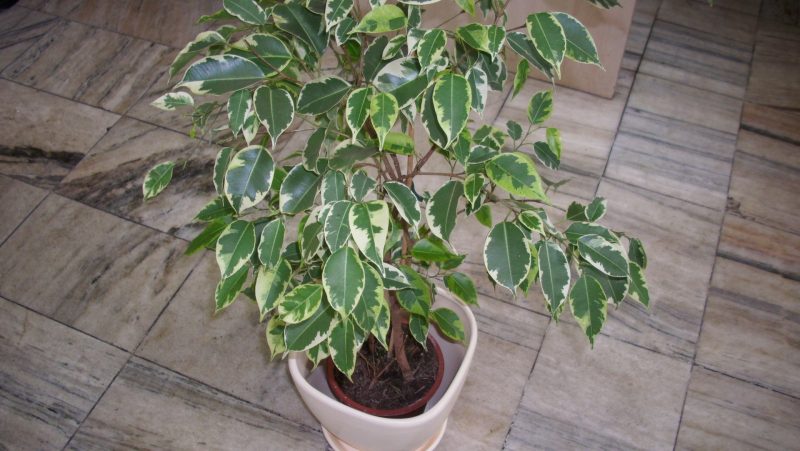
- In the summer, a pot with a plant can be identified on the street.
- In winter, the main condition for detention is to prevent the air temperature from falling below 13-15 degrees.
It should be noted that the plant does not tolerate strong drafts and winds. Ficus is a lover of hot climate and bright sun, so he needs to provide a well-lit place, with some shading from direct sunlight.
Important! For intensive growth, the plant needs good lighting. With insufficient light, it slows down the growth rate, loses its decorative effect, and its leaves become pale.
- In the summer, a pot with a potted flower can be placed on the balcony. In winter, he will need additional lighting using artificial lamps.
- You can not often rearrange the pot with a tree in a new place - this can adversely affect the appearance and growth of the plant.
- Ficus puts forward certain requirements for the level of humidity. It must be sprayed daily with clean and well-maintained water at room temperature. In the summer, it is allowed to shower him, and in winter it is especially important to maintain humidity if the ficus grows close to the radiator.
Soil requirements
The soil must be given special attention. It should be light, loose, freely pass air to the roots. In a plant, they are fragile, so they have a hard time in dense soil.

For planting, you can buy in stores ready-made soil intended for ficus.
Or prepare it yourself, mixing the components in equal parts:
- turf land;
- sheet earth;
- peat;
- sand;
- vermiculite.
For adult plants, you can choose a slightly more dense soil.
Watering and feeding
The frequency of watering ficus directly depends on the state of the topsoil in the pot.
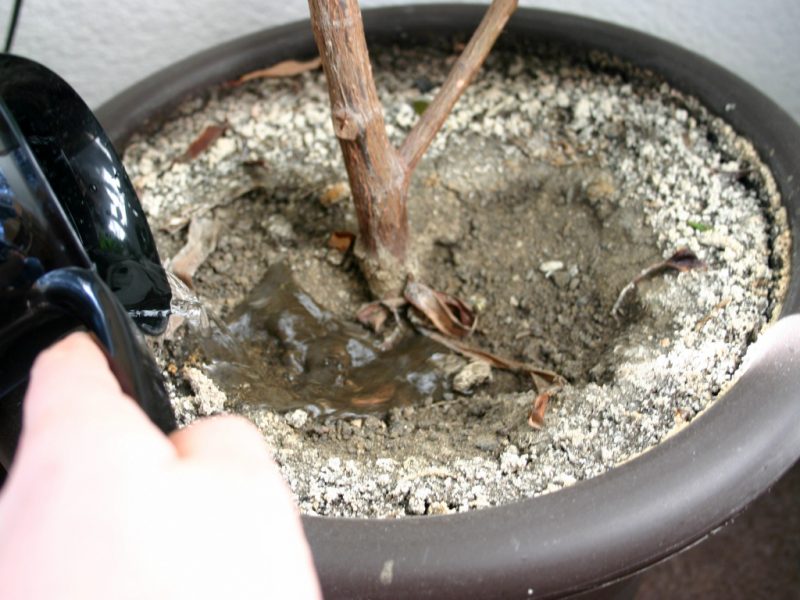
- In the summer, watering should be done 2-3 times a week.
- In winter, their number is reduced to 1 time per week.
The main signal of a lack of water will be a dried-up earthen lump and drooping foliage.
In order to ensure active growth of the plant, timely top-dressing is necessary. Organic fertilizers are also allowed.
- Begin to make them necessary in the month of March.
- In summer, ficus should be fed every 2 weeks.
- In winter, the plant is fertilized 1 time for the entire period.
Cropping and shaping the crown
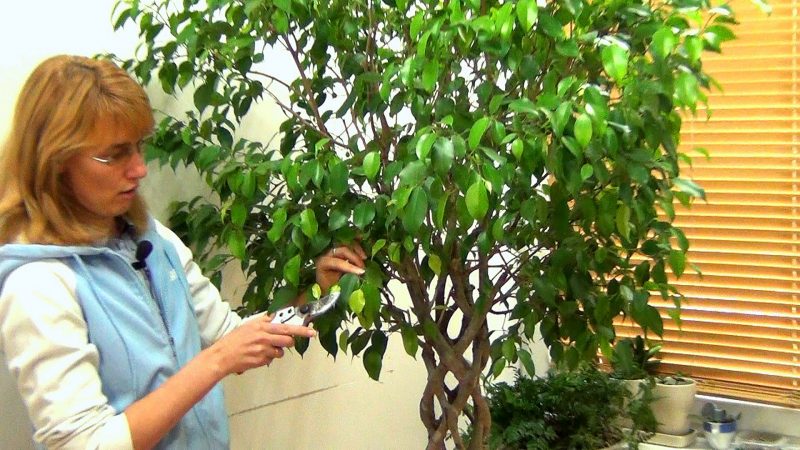
The crucial step in the care is trimming and shaping the crown, which can be given various shapes. Benjamin's ficus should be cut off with the onset of spring, during the active growth of shoots.
This process helps the plant accelerate growth and build green mass in the summer.
Plant transplant

Transplant the plant as necessary:
- After buying a ficus, it must be transplanted after 2 weeks from the shipping pot.
- If the roots of the plant appeared from the drainage hole, this means that the capacity has become small.
- When the soil in the pot is affected by fungus or mold.
An adult plant requires a change of pot 1 time in 3-4 years. Between transplants, it is necessary to regularly pour a fresh topsoil.
The main condition for the success of a plant transplant is a properly selected pot. It should be 2 cm in diameter larger than before.
Actions during transplantation:
- Place drainage of expanded clay or pebbles at the bottom of the container.
- Carefully remove the plant from the pot without damaging the fragile roots.
- Inspect them, remove rotten parts.
- In the new ground, make a hole
- Place a tree in it, slightly compacting the earth around.
- After all the manipulations, the plant should not be watered for 4-5 days.
Important! To avoid rooting problems, you can pre-sustain the plant in the Kornevin solution for 2 hours.
Reproduction of ficus Benjamin
Reproduction of ficus Benjamin can begin in the early spring or in the first summer month, when the plant has grown strongly and actively.
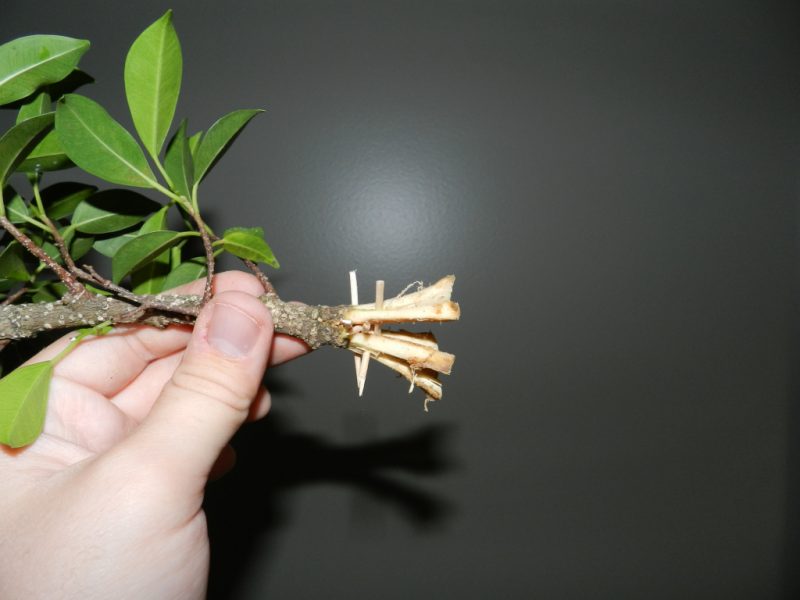
The most convenient ways of breeding at home are:
- division by cuttings;
- propagation by leaf.
The easiest way to propagate ficus is cuttings.
- For this, it is necessary to prepare cuttings, each of which has 2-3 leaves.
- They should be cut with a sharp sterile knife.
- After that, the workpieces are placed in water or in prepared containers with moist soil.
- In a glass, it is recommended to change water daily. The roots appear in a week.
- Then the rooted cuttings are planted in a pot. You can plant it first in a moist, loose substrate by putting on top of the bag. After 2 weeks, the greenhouse is removed.
Leaf propagation is practically no different from cuttings. A leaf is cut off from the bottom of the trunk of the plant and placed in a glass with clean water. Or it is planted immediately in the soil.
Important! For quick rooting of the sheet, it is necessary to create optimal conditions for it: good lighting, temperature of 25 degrees and humidity.
Pests and diseases - how to treat?
An unpretentious plant is very rarely exposed to diseases and pests. Most often, it suffers from improper care and a lack of optimal conditions.
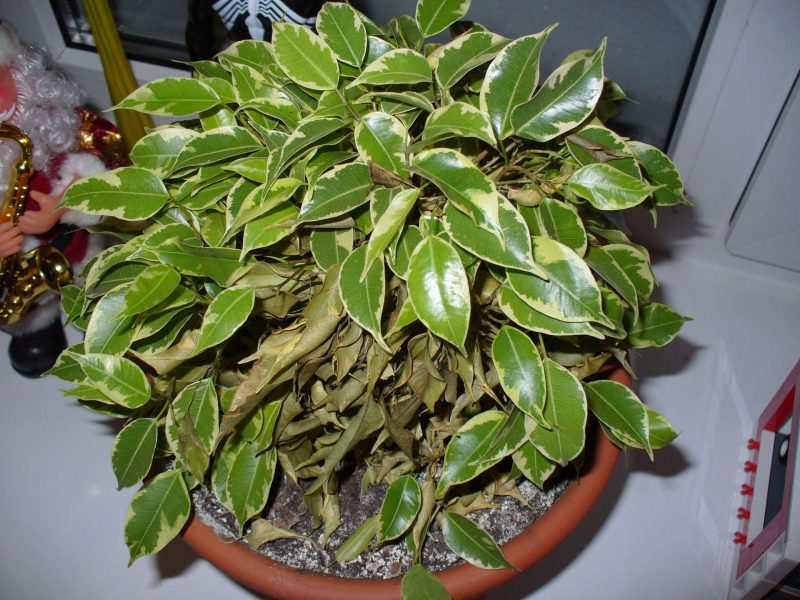
Rarely, common pests can appear on a tree:
- spider mite;
- scale shield;
- aphid;
- mealybug.
To get rid of harmful insects, it is necessary to thoroughly wash the leaves with soap and water, treat with fungicides or Bordeaux liquid.
What problems can the flower grower face?
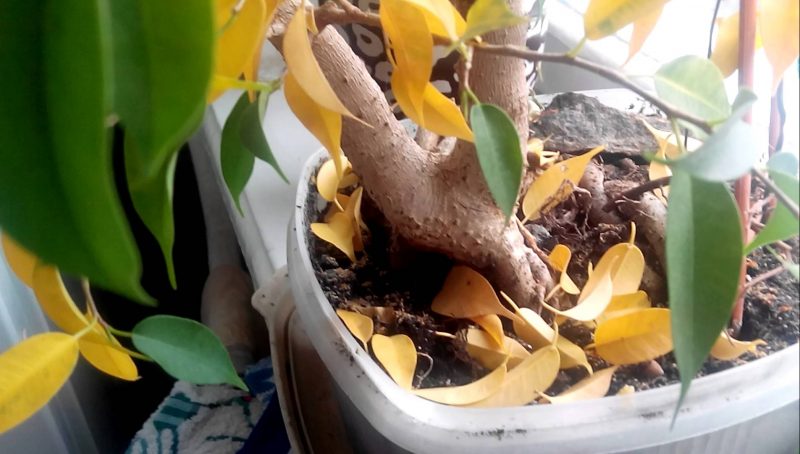
In the absence of proper care and growing conditions, some problems may arise.
- Very often, ficus drops its leaves. The main reason for this condition is insufficient lighting.
- Direct sunlight provokes burns to the crown of the plant. The leaves turn brown, wrap at the tips and fall off.
- Drying foliage may be due to insufficient watering and low humidity.
- Foliage curls at low temperatures.
- Shedding of the crown can also occur due to excessive watering, which led to the decay of the root system. In this case, it is necessary to reduce the amount of watering, replace the soil in the pot with a new substrate, forming good drainage.
With proper care and attention, the ficus will decorate the house with its decorative appearance, as well as clean the air in the room from harmful impurities. Even inexperienced gardeners can grow a beautiful and healthy tree.












